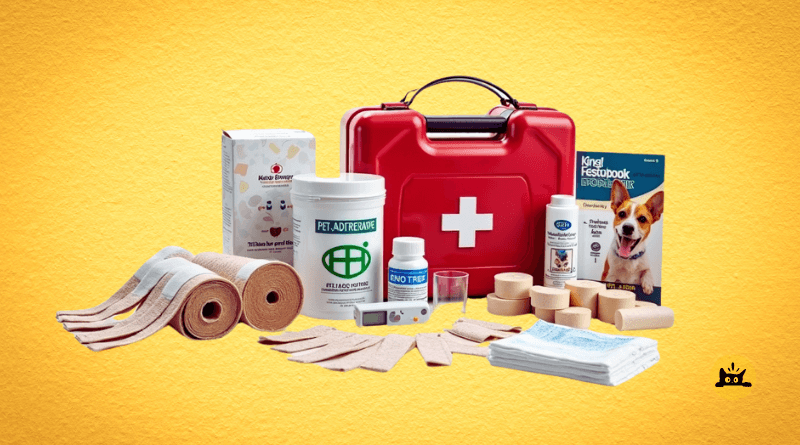When something sudden happens with your pet, having a pet emergency kit that is set up and ready can make all the difference. Pets are part of the family, and being prepared to help can quickly ease your worries and keep your pet safe until you can get help from your vet.
Why an Emergency Kit is Essential
Every pet owner should think about the chance of surprise accidents or unexpected health problems. Even in the safest environment, your pet might get a small cut, burn, or even have an allergic reaction. These small issues can get worse if not treated properly. Having a handy kit allows you to help your pet stay calm and feel better while you call your vet. Many top pet experts say that regularly checking and restocking your kit is a key way to show you care—and it can be a lifesaver when every minute counts.
Essential Items for Your Pet Emergency Kit
Putting together a useful first aid kit for your pet means choosing items that can help with many problems. Leading pet experts suggest keeping your kit complete but easy to use, especially when every minute matters.
Wound Care Supplies
Taking care of wounds is very important for stopping germs and helping your pet get better faster. Consider including: • Nonstick bandages – These help cover cuts without pulling on the fur or hurting the skin. • Soft gauze bandages – Use these to gently clean cuts and press on the area to slow down bleeding, then keep the bandage in place. • Germ-killing wipes or washes – These help cut down on germs and stop infections. • Safe tape for pets – This pet-friendly tape keeps the bandages where they belong without irritating the skin.
Essential Tools and Equipment
Keeping the right tools nearby can mean the difference between a small problem and a big one: • A good quality thermometer – This lets you check your pet’s temperature and see if they are okay. • A pair of scissors and tweezers – These are useful for cutting bandages or taking out any dirt or small objects from a wound. • Soft cotton sticks – Great for putting on cream or wiping little spots. • One-time use gloves – Keeping things clean is important, so these help protect you and your pet from germs. • A warm emergency blanket – Cover your pet with a warm blanket to help keep them comfortable, especially if they are very upset.
Medications and Miscellaneous Supplies
Before giving any medicines, talk with your vet first. However, there are a few helpful things you might want to have: • Medicines for pain and reducing swelling – These can help with a little pain; use them only when your vet says it’s okay. • Allergy medicines – If your pet shows signs of an allergic reaction, the right amount approved by your vet can help ease the symptoms. • Your pet’s health records and vet contact info – Keeping this information nearby makes sure you have all the important details quickly available. • A pet first aid guide – A simple guide with easy-to-follow instructions can be very useful during an emergency.
Practical Guidelines for Emergency Situations
When something sudden happens, staying calm is your best tool. Here are some simple steps to follow: • Take a deep breath and check your pet carefully – Look for trouble breathing, lots of bleeding, or clear signs of pain. Staying calm helps you use your kit properly. • Quick care for your pet’s cuts – If the injury is small, use your nonstick bandages, soft gauze, and germ-killing wipes. Then, call your vet right away. • Make sure your pet is as comfortable as possible – Cover your pet with a warm blanket to help keep them cozy and soothe them until help arrives. • Call your vet right away – Even if the injury looks small, getting professional help ensures that no complications develop later.
Maintaining and Updating Your Kit
Your pet’s first aid kit isn’t just something you buy once—it needs regular checking. Items can go bad over time, and your pet might need different things as they grow. To make sure your kit always works: • Check the expiration dates often – Swap out old items and restock what you use. • Keep your kit somewhere you can get to quickly – Choose an easy-to-reach spot so you can grab it fast when needed. • Change the kit when necessary – If your pet needs extra care or if your vet suggests new items, update your kit to match those needs.
Additional Considerations
Each pet has its own needs, depending on its type, size, and health. For pets that already have health issues or special needs, talk to your vet about any extra items you might need. For example, older pets might need extra supplements or special care items, while younger, active pets might need extra bandages and cleaning supplies. Also, include a small card showing your pet’s vaccinations, allergies, and any regular medicines. This little card can help when every minute matters.
Conclusion
Putting together an emergency first aid kit for your pet is a key part of being a good pet owner. By spending a little time to put together and keep your kit updated, you’re taking care of your pet both now and in the future. Being prepared can turn a scary emergency into something you can handle, helping both you and your pet feel better and recover quicker. A little preparation today means that if something happens, you’ll know what to do and have everything you need right at hand.
Sources : Veterinary Information Network, British Small Animal Veterinary Association, American Animal Hospital Association

